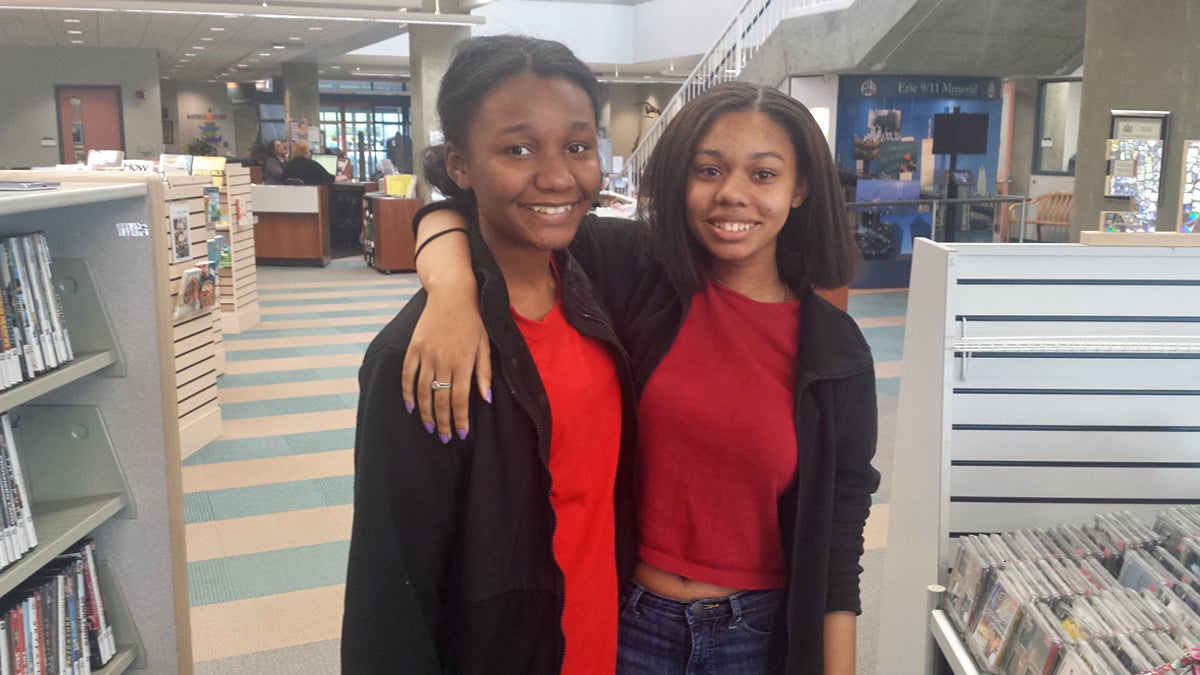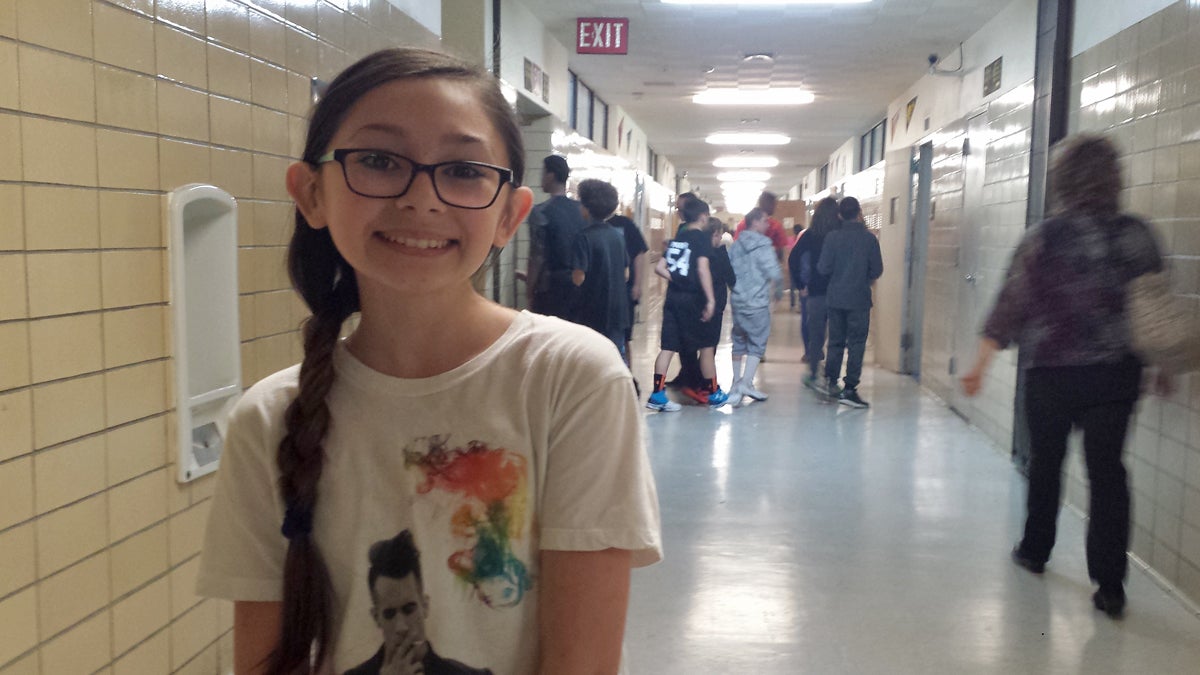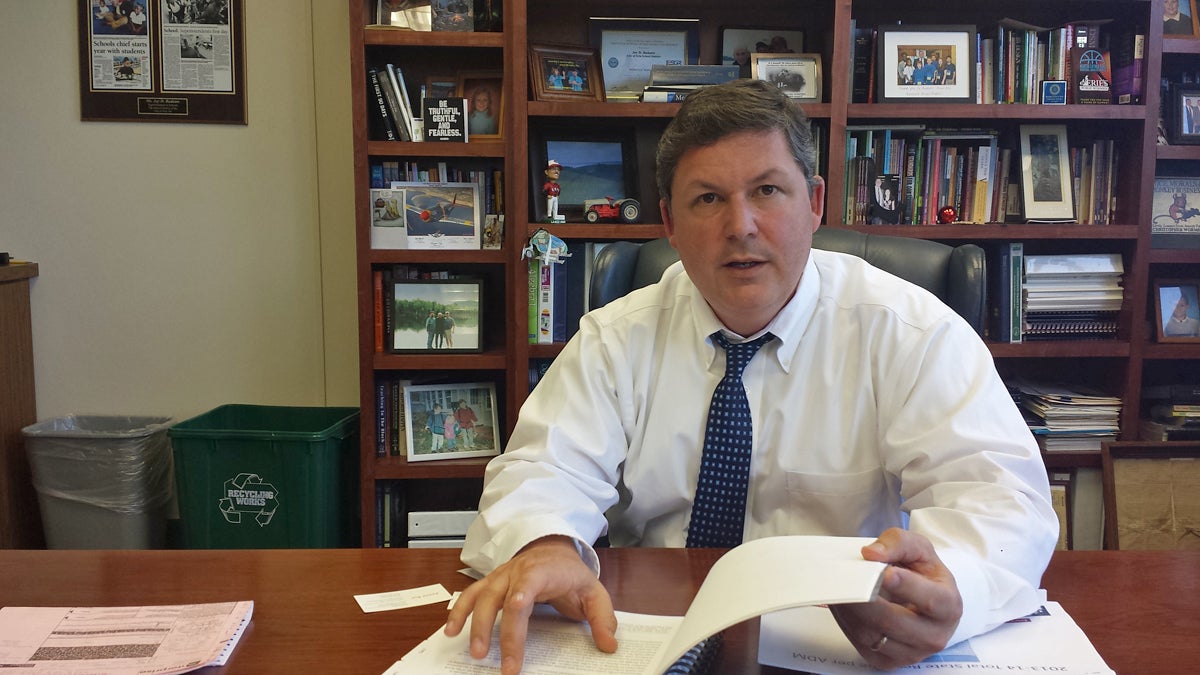In Erie, the school integration plan that could fast-track equity
Listen
Whitney Henderson (right) with Dominique Booker are both Strong Vincent High School students in Erie, Pa. (Kevin McCorry/WHYY)
On the edge of insolvency, district studies controversial proposal
In the waning days of the school year, a group of students at Strong Vincent High School in the city of Erie sat around a large wooden table in the library, discussing how they feel their school is perceived out in the suburbs.
Nathan Stevens, a white junior, was one of the first to chime in.
“We’re a city school and the surrounding districts are higher income and they always think that they’re better than us,” he said. “That’s just how it works around here.”
Whitney Henderson, an African-American sophomore, spoke next.
“Everybody thinks it’s a ghetto school, or that the people that go here are dumb, or bad,” she said.
Based on what?
“Stereotypes,” said Henderson.
This conversation has become especially pertinent.
In the face of systemically inequitable state funding, the superintendent of Erie Public Schools has proposed the possibility of shutting down all city high schools and busing students to the better-resourced suburban districts.
Superintendent Jay Badams has floated this idea as a way to ensure that the kids get a fair education in the midst of chronic budget shortfalls.
Between the lines, this would amount to a major race and class integration effort.
“This is the sixth consecutive year of cutting budgets,” he said. “If we have to cut things like sports, art, music, [then] we’re taking away from students who already have fewer opportunities than their peers in school districts here in Erie County.”
In part one of this series, Keystone Crossroads analyzed the policies and trends that led to Erie’s fiscal plight.
In theory, if Erie followed through with the closure plan, they’d forward the money they spend on each high schooler to that student’s new district.
So, the monetary savings would not be very significant.
“For us, this is as much about equity than it is about finances,” said Badams.
But the proposal has made waves, especially in the nearby school districts, which include Millcreek, Harbor Creek, Iroquois, Fairview and General McLane.
And the racial and socioeconomic math is hard to ignore.
Erie is by far the poorest district in the county, with a median household income of about $33,000.
Minority students make up 57 percent of the Erie public schools population. No other district in Erie County exceeds 12 percent.
The students in Erie can feel this dynamic as well as anyone.
“If I went to Harbor Creek, or if I went to McDowell, I’d feel like an outcast because of my skin color, because I’m black,” said Henderson, referencing one suburban district and another suburban high school. “And everybody that goes there is pretty much white.”
Her classmate Gabe Martin, also African-American, agrees.
“Racism still exists. It’s not going away. White people are going to look down upon black people. That still exists,” said Martin. “And if we split up these schools, we have black kids, kids that go here, go to McDowell, they’re just going to be looked down on.”

Riley Moran, student at Roosevelt Middle School in Erie, Pennsylvania (Kevin McCorry/WHYY)
Elementary school students feel the stigma as well.
“A lot of Millcreek schools don’t really want us coming, as if we’re such bad kids, when there’s a lot of bright students here,” said Riley Moran, a 12-year-old who attends Erie’s Roosevelt Middle School. She has dreams of becoming a surgeon.
“They don’t give us a chance,” she said.
Racial and Socioeconomic make up
‘City kids’
In a cozy coffee shop in suburban Erie, Millcreek School District mom Genene Mattern says she’d welcome the city students into her district, but acknowledges that’s not the mindset of many others.
“I get a little upset when I hear other parents who are against it totally, because they don’t want ‘Erie city kids,'” said Mattern. “Okay, well now you’re almost trying to put a racial spin on it, and that to me is wrong. They’re children. I don’t care what color, what ethnic background, what social background, they deserve a chance.”
Many of the superintendents in outlying districts, including Millcreek, have said much the same.
So, too, has Sean Wiley, a Democratic state senator who represents Erie and the immediate suburbs.
“These are not city kids. These are not county kids,” he said. “These are our kids across this entire region.”
But the proposal has been the subject of vitriol on social media, where some parents have disparaged Erie students and parents.
Interview requests with those posters went unanswered, and recent headlines of city violence — some of it involving high-school-aged perpetrators in gangs — likely aren’t warming them to the idea.
Those in the suburbs who are willing to speak against the high school closure plan point to logistical concerns.
“There really isn’t the capacity in the neighboring school districts to absorb 3,200 students,” said Millcreek parent Thomas Pendleton, who’s worried about rising class sizes.
State Rep. Curt Sonney, a Republican who represents a slew of outlying districts, also argues against it.
“We can’t let that happen,” he said. “It’s difficult on any student to have to bus them for miles to a strange new school with all new people.”
Sonny also questions whether the surrounding districts could properly educate Erie’s students at the city district’s per-pupil rate.
“I’m not so certain that it works,” he said. “Just because the Erie School District works with their numbers, I’m not so certain that the reality of it, that it does work with those numbers.”
A ‘tying mechanism’
There’s a growing body of educators and researchers who say that figuring out the logistics of this proposal would be well worth the extra effort.
At their core, integration plans are a ‘tying mechanism.’
“If the outcomes and the benefits that a school can provide to the son of a janitor are tied to those of the son of a congressman, then they are more likely to get those resources, right?” said Kimberly Quick, a policy associate at the Century Foundation, a D.C.-based think tank that advocates for school integration.
Its research finds that integration, when planned and executed well, has historically led to major boons for low-income and minority students.
Century says this happens, in large part, based on the superior quality and quantity of resources and teachers generally made available to richer and whiter schools.
“And that’s how we need to frame this, instead of making it sound like something magical happens when black kids sit next to white kids,” said Quick.
Century also argues that suburban parents don’t need to worry about a negative effect on their children.
“There’s no evidence that points to that,” said Quick.
A county comparison
The issue in Erie is even more complicated because of Pennsylvania’s education funding policies, which have largely ignored the actual needs of students for the past twenty-five years.
So although Erie is one of the state’s most challenged districts, the state sends more money per-pupil from its main pot of cash to most other districts in the county.
That includes wealthier ones, with less pressing needs, that already have an easier time raising local funds.
In the interactive chart below, majority white districts are featured in green; others in black.
Local wealth vs state aid in Erie County
“The differences between the resources we have in the county compared to in here are just shocking,” said Brian Polito, chief financial officer for Erie Public Schools.
Before, Polito held a similar position in North East, a rural district in the county. To illustrate the difference with an example, he said, last year Erie spent $6,000 dollars on its 18 libraries.
“In the school district that I came from we had three libraries, and our budget for library resources was almost $40,000,” he said.
Until recently, the state gave no systematic funding boost to districts tasked with educating non-native speakers. As a federal refugee resettlement area with a large Nepalese population, this too has been an unrecognized burden on Erie’s shoulders.
“Diversity for us, I think, is a huge strength, and not a challenge to overcome,” said Badams, “but there are costs associated with providing the support and the additional instruction for students who don’t know English.”

Jay Badams, superintendent of Erie Public Schools (Kevin McCorry/WHYY)
It’s based on examples like these that has Millcreek parent Genene Mattern completely supporting the stand that superintendent Badams has taken.
“People need to get mad. People need to get loud, because the more you just sit and let it happen, I think the more they figure, ‘well, they’re okay with that,'” she said.
The entire prospect, though, leads to a larger racial question:
Would Erie’s crisis even be happening if it was a majority white district?
Erie, and many other urban, majority-minority districts, would see a windfall if state leaders chose to implement the state’s new student-weighted funding formula more aggressively.
But legislative leaders — who on the whole represent whiter, more rural districts that have benefitted from the lack of a formula for the past two decades — have decided against fast-tracking equity.
Would there be a difference if the districts suffering most were a different color?
Keystone Crossroads posed those questions to Whitney Henderson and her best friend Dominique Booker, both sophomores at Strong Vincent High School.
Whitney references three of Erie’s schools.
“I don’t think if the majority of students that went to [Strong Vincent] or East or Central were white there’d be this problem,” she said.
Dominique wants to have a more hopeful outlook.
“I’m like, I don’t think so, but then I just question,” she said. “I really don’t know. It’s a really hard question because you look … and they have more money, more stuff, but I don’t want to think that way.”
WHYY is your source for fact-based, in-depth journalism and information. As a nonprofit organization, we rely on financial support from readers like you. Please give today.



